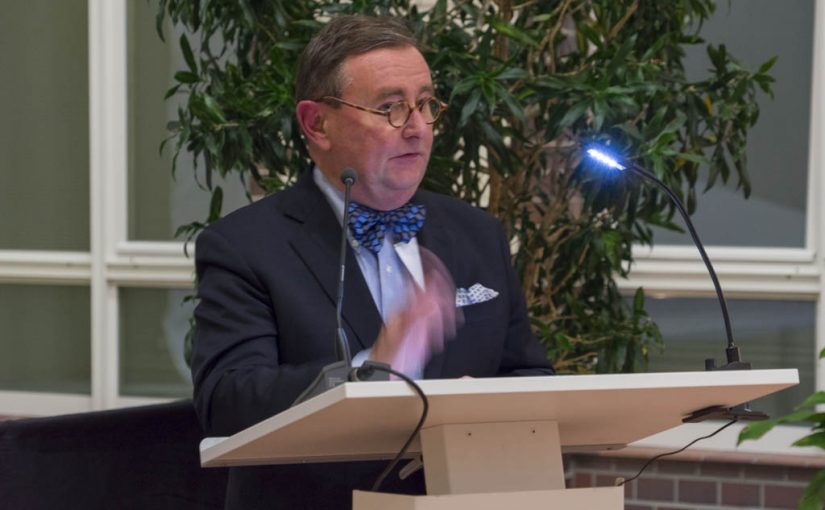Grant Marani FRAIA
It is remarkable to have so many Australian architects gathered abroad in a location other than Venice. Venice of course is our biennial celebration and contribution, in a specific form, to the speculative world of architectural discourse, but in Berlin we gather to consider and celebrate in a global colloquium the far more demanding achievement of great buildings that have actually been built. And we Australians have made quite a contribution to the proceedings of the World Architecture Festival, with more than 30 shortlisted projects involving more than 20 practices. Not too shabby at all.
We are both privileged and delighted to be the guests of the Ambassador, Her Excellency Lynette Wood. With 2016 marking the first in the series of World Architecture Festival events in Berlin, we hope we can look forward to continuing engagement in future years. We are also excited by the prospects on offer into the near future, with the Australian Government’s Department of Foreign Affairs and Trade having designated Germany as the focus for its cultural diplomacy program, ‘Australia Now‘, in 2017.
It is interesting to note that a recent report of the Australia-Germany Advisory Group acknowledges many similarities between our respective countries – our common interests and shared values; our demonstrated international leadership; our active roles internationally including increasing engagement in the Indo-Pacific, the world’s fastest growing region; and specifically for us as architects, high quality education, research and cultural sectors.
In many respects Germany is the logical home for a celebration of modern architecture and its attendant principles. From this base Australian architects have had much to contribute, both from the point of view of what has been described as thought leadership, local engagement, but perhaps more than that, a sense of relentless optimism, which is very important indeed. I’ve been told that it was only recently that the doyen of architectural wisdom, Kevin McCloud – at the time reflecting on the advent of modern architecture in Australia – was remarking across television sets in Australia that Australian architects have much to offer the world.
Some of this contribution is the subject of the World Architecture Festival. Projects by Australian architects, as well as projects based in Australia, are shortlisted in 14 of the 18 ‘completed’ categories, and 7 of the 11 ‘future’ categories. Perhaps, not so surprisingly to us, we do very well in the areas of education, health and office design, as well as being responsible for some exquisite places in which to live. At the same time our civic, social and community infrastructure are in various respects being recognized for their inventiveness and quality.
What does this all mean? In part this is an endorsement of the quality of our Australian architectural culture, which is just as much demonstrated by the Australian Institute of Architects National Architecture Awards program. But it is also indicative of the quality of our export potential. Architects are by nature students of the world, but this seems to have a particular resonance for Australian architects – perhaps by virtue of our relative geographic dislocation. We have to learn quickly how to observe, adapt and engage with the world around us.
To this end, by way of example, the Institute has through its International Chapter this year been re-evaluating its role in the international arena. Work is ongoing, but the results of our research thus far are very interesting. Through our members, we are far more internationally engaged than perhaps we first realized – and this stands only to grow into the future as the value of the Australian architectural education and accreditation system grow in standing. The Institute looks forward to continuing to engage both through our members as well as in partnership with Government.
But more than that, there is the underlying phenomenon of spirit – in many respects the ‘why’ of architecture. Here in Germany we can see it in the advent of modernism; and in a ‘young’ country like Australia we observe parallels in our depth of culture, a modern sensibility informed by our unique Indigenous heritage.
Nearly a century ago the great German architect Bruno Taut penned his anthology Die Stadtkrone (1919), in which he wrote:
“To view architecture as nothing more than nicely designed functional forms or as ornamental wrappings around our essential needs is to assign it to the role of a craft and places too little value of its importance in our lives. […] architecture is an art, a play of fantasy”.
This was at the dawn of the age of European Modernism, and it was a call to build the ideal rather than perpetuate the average – what the brilliant Robin Boyd might have called our ‘ugliness’. Perhaps this is as much the call for Australian architects today, as we press forward in this dynamic Asian century.

